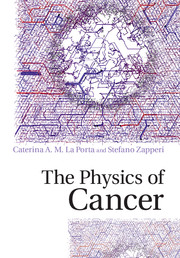Book contents
- Frontmatter
- Dedication
- Contents
- Preface
- 1 Introduction to the Cell
- 2 The Biology of Cancer
- 3 A Modeling Toolbox for Cancer Growth
- 4 Vascular Hydrodynamics and Tumor Angiogenesis
- 5 Cancer Stem Cells and the Population Dynamics of Tumors
- 6 Biomechanics of Cancer
- 7 Cancer Cell Migration
- 8 Chromosome and Chromatin Dynamics in Cancer
- 9 Control of Tumor Growth by the Immune System
- 10 Pharmacological Approaches: Old and New
- 11 Outlook on the Physics of Cancer: A New Interdisciplinary Area
- References
- Index
Preface
Published online by Cambridge University Press: 04 May 2017
- Frontmatter
- Dedication
- Contents
- Preface
- 1 Introduction to the Cell
- 2 The Biology of Cancer
- 3 A Modeling Toolbox for Cancer Growth
- 4 Vascular Hydrodynamics and Tumor Angiogenesis
- 5 Cancer Stem Cells and the Population Dynamics of Tumors
- 6 Biomechanics of Cancer
- 7 Cancer Cell Migration
- 8 Chromosome and Chromatin Dynamics in Cancer
- 9 Control of Tumor Growth by the Immune System
- 10 Pharmacological Approaches: Old and New
- 11 Outlook on the Physics of Cancer: A New Interdisciplinary Area
- References
- Index
Summary
Understanding how cancer initiates, grows and migrates has been a fundamental topic of biomedical research in the past decades and is still the object of intense scientific activity. Cancer is a complex disease where many factors cooperate. According to the 2000 seminal paper by Hanahan and Weinberg, six biological capabilities (the hallmarks of cancer) encapsulate the key features describing the remarkable variability displayed by cancer: sustaining proliferative signaling, evading growth suppression, activating invasion and metastasis, inducing angiogenesis, resisting cell death, activating invasion and metastasis, enabling replicative immortality (Hanahan and Weinberg, 2000). In a more recent review, the same authors take into account the observations that emerged in the previous ten years and add four new hallmarks: avoiding immune destruction, promoting inflammation, genome instability and mutation, deregulating cellular energetics (Hanahan and Weinberg, 2011). Hence, after ten years the hallmarks of cancer are still to be understood and have even increased in number! This is a signal in our opinion that traditional approaches need new strings in their bows. Tumors are extremely heterogeneous and their growth depends on dynamical interactions among cancer cells and between cells and the constantly changing microenvironment. All these interactive processes act together to control cell proliferation, apoptosis and migration. There is an increasing consensus that these dynamical interactions cannot be investigated purely through single biological experiments because experimental complexity usually restricts the accessible spatial and temporal scales of observations. Therefore it is necessary to study cancer as a complex system.
Advances in systems biology are already beginning to have an impact on medicine through the use of computer simulations for drug discovery. The integration of new experimental physics techniques in cancer research may help improve, for example, the capability to design more efficient cancer therapies. Understanding the biology of cancer cells and the impact of physical mechanisms, such as cell and tissue mechanics, on their biological functions could help validate biomarkers and develop more accurate diagnostic tools and individualized cancer therapies. In the past years, clinical studies have relied heavily on conventional population-based randomized clinical trials that try to identify favorable outcomes as an average over the population. Cancers are, however, extremely heterogeneous even within the same tumor class, so that an average positive outcome does not necessarily translate to a positive outcome in individual cases.
- Type
- Chapter
- Information
- The Physics of Cancer , pp. xi - xivPublisher: Cambridge University PressPrint publication year: 2017

